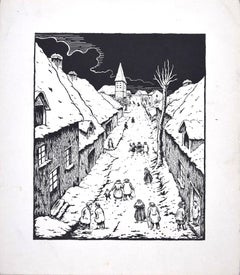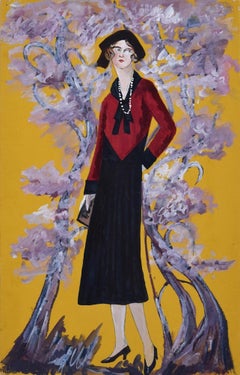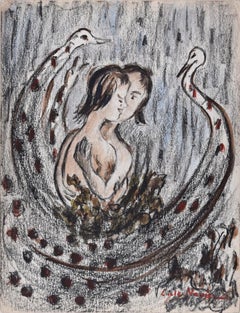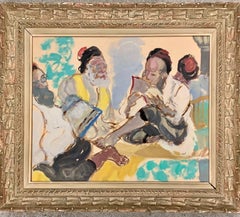Lucie Navier Art
1
to
2
8
5
3
8
Overall Height
to
Overall Width
to
5
6
4
4
2
2
1
1
1
1
1
1
1
1
1
1
1
8
1
7
8
6,996
3,377
2,513
1,212
7
5
2
2
2
Artist: Lucie Navier
Poseidon - Ink and Tempera on Paper by Lucie Navier - 1933
By Lucie Navier
Located in Roma, IT
Poseidon is an original painting realized by Lucie Navier in 1933.
Original Ink and tempera painting on paper.
Dated on the lower right corner (23-6-2033).
Fair conditions except...
Category
1930s Modern Lucie Navier Art
Materials
Tempera, Watercolor, Ink
Marine - Tempera on Paper by Lucie Navier - 1927
By Lucie Navier
Located in Roma, IT
Marine is a painting realized by Lucie Navier in the 1927.
Tempera on paper.
Mint conditions.
Impressionistic work realized with a Realistic technique and representing a natural...
Category
1920s Modern Lucie Navier Art
Materials
Tempera
Muslim - Original Mixed Media on Paper by Lucie Navier - 1930s
By Lucie Navier
Located in Roma, IT
Muslim is an original painting realized by Lucie Navier.
Original tempera painting on paper. The sheet is glued on green cardboard (cm 30.5 x 25).
Very good conditions.
Colorful ...
Category
1930s Lucie Navier Art
Materials
Tempera, Watercolor, Ink
Nocturnal Village - Original Screen Print by Lucie Navier
By Lucie Navier
Located in Roma, IT
Nocturnal Village is an original artwork realized by the French artist Lucie Navier (1910-1996) in the 1930s.
Original black and white serigraph...
Category
1930s Modern Lucie Navier Art
Materials
Screen
Madame in the Blossom Garden - Tempera on Paper by Lucie Navier - 1931
By Lucie Navier
Located in Roma, IT
Madame in the blossom garden is an original painting realized by Lucie Navier in the 1931.
Original tempera on paper.
Very good conditions.
Colorful composition representing a f...
Category
1930s Modern Lucie Navier Art
Materials
Tempera
Peacocks - Original Mixed Media on Paper by Lucie Navier - 1930s
By Lucie Navier
Located in Roma, IT
Peacocks is a painting realized by Lucie Navier in the 1930s.
Original tempera painting and pastels on cardboard.
Hand-signed by the artist on the lower right corner in red paintin...
Category
1930s Modern Lucie Navier Art
Materials
Tempera, Pastel
Young Blonde Girl - Original Oil on Cardboard by Lucie Navier - 1930s
By Lucie Navier
Located in Roma, IT
Young Blonde Girl is an original painting realized by Lucie Navier in the 1930s.
Original oil painting on cardboard.
Hand-signed by the artist on the lo...
Category
1930s Lucie Navier Art
Materials
Oil
In the Woods - Original Oil Painting by Lucie Navier - 1931
By Lucie Navier
Located in Roma, IT
In the Woods is an original painting realized by Lucie Navier in the 1931.
Original oil painting on cardboard.
Hand-signed on the lower right corner.
Very good conditions.
Col...
Category
1930s Lucie Navier Art
Materials
Oil, Cardboard
Related Items
Rabbit Hunters
By Roger Medearis
Located in Los Angeles, CA
Rabbit Hunters, egg tempera on Masonite, 12 x 9 inches, 1947, signed and dated lower left, signed, titled and dated verso “Rabbit Hunters Egg Tempera Roger Medearis 1947,” exhibited at Medearis' solo show at Kende Galleries, New York, in 1949 (Medearis’ record book, a copy of which is held by Vose Galleries in Boston, MA, indicates this is painting “No. 23” and that is was completed in 1947 and sold via Kende Galleries (at Gimbel Brothers...
Category
1940s American Modern Lucie Navier Art
Materials
Tempera, Board
Russian French Judaica Jewish Gouache Painting Sephardic Rabbi, Jerusalem Israel
By Mane Katz
Located in Surfside, FL
Mané-Katz (1894 - 1962)
SCHOLARS AT STUDY
Signed Mané Katz (lower right)
Tempera (gouache) on paper laid down on card.
19 3/4 by 23 5/8 in. (50.2 by 60.1 cm) sight size.
Frame size is 27 X 31 inches.
Provenance: Sotheby's Impressionist & Modern art, 8 June 2017 (consigned by original owner who purchased it directly from artist)
Mane-Katz (1894-1962) was a Litvak painter born in Ukraine best known for his depictions of the Jewish shtetl in Eastern Europe. Emmanuel Mané-Katz (Hebrew:מאנה כץ), born Mane Leyzerovich Kats (1894–1962), was a Litvak painter born in Kremenchuk, Ukraine, best known for his depictions of the Jewish shtetl in Eastern Europe. Particularly music figures and Jewish wedding scenes.
Mane-Katz moved to Paris at the age of 19 to study art, although his father wanted him to be a rabbi. During the First World War he returned to Russia, at first working and exhibiting in Petrograd; following the October revolution, he traveled back to Kremenchuk, where he taught art. In 1921, due to the ongoing fighting in his hometown during the civil war, he moved once again to Paris. There he became friends with Pablo Picasso and other important French artists, and was affiliated with the art movement known as the School of Paris; together with other outstanding Jewish artists of that milieu, he is sometimes considered to be part of a group referred to specifically as the Jewish School of Paris. Includes Russian, Ukrainian and Polish painters Jankel Adler, Arbit Blatas, Marc Chagall, Jacques Chapiro, Michel Kikoine, Pinchus Kremegne, Sigmund Menkes, Jules Pascin, Issachar Ryback, Jacques Lipchitz,Chana Orloff, and Ossip Zadkine. Ecole de Paris
In 1931, Mane-Katz's painting The Wailing Wall was awarded a gold medal at the Paris World's Fair. Early on, his style was classical and somber, but his palette changed in later years to bright, primary colors, with an emphasis on Jewish themes. His oils feature Judaic Hasidic characters, rabbis, Jewish musicians, beggars, yeshiva students and scenes from the East European shtetl made famous in the west by Sholem Aleichem and Tevye.
Mane-Katz made his first trip to Mandate Palestine in 1928, and thereafter visited the country annually. He said his actual home was Paris, but his spiritual home was Eretz Yisrael, the Land of Israel. In 1939, as World War II was breaking out, he was drafted by the French and then was taken prisoner by the Germans. He escaped and went to the United States and remained there until 1945, exhibiting his paintings at Katia Granoff Gallery and Wildenstein Gallery. After the war, he returned to Paris where he had exhibited in the Salons. In Paris to the end of his career, he worked happily, painting hundreds of portraits of rabbis...
Category
Mid-20th Century Modern Lucie Navier Art
Materials
Tempera, Gouache
Splash Girl - Original painting, Signed
By Philippe Pasqua
Located in Paris, FR
Philippe Pasqua (1965-)
Splash Girl, 2010
Mixed medias : ink, watercolor and acrylic painting
Signed bottom right
Authenticated with the artist red stamp
On...
Category
2010s Modern Lucie Navier Art
Materials
Ink, Acrylic, Watercolor
Untitled, Tempera on Board by Modern Indian Artist Lalu Prasad Shaw "In Stock"
By Lalu Prasad Shaw
Located in Kolkata, West Bengal
Lalu Prasad Shaw - Untitled - 25 x 20.5 inches
Tempera on Board, 2015
Style : Known widely for his highly stylized portraits of Bengali women and couples, Lalu Prasad Shaw’s works lay the most emphasis on his subject’s physical characteristics. Capturing the expressions of his subjects perfectly with the greatest economy of line and colour each of Shaw’s paintings has an intimate feel to it.
Influenced by the pre-independence Company School of art, the traditional Kalighat Pat and the Ajanta cave paintings, Shaw’s works, mainly executed in gouache or tempera, like his own person, are simple and graceful, having a very still, well-composed and smooth exterior. This senior artist draws his inspiration primarily from nature and the milieu surrounding the great Bengali middle class, often depicting pleasant and quiet scenes from his own life on his canvases and papers. His style is unique and modern in its adaptation of academic and traditional Indian formats.
A particularly notable aspect of Shaw's paintings is their simple yet sophisticated look. One notices a seamless synthesis of different stylistic elements to achieve a phenomenal effect.
About the Artist and his work :
Born : 1937 in Bengal.
Education : completed his education in fine arts at the Government College of Arts and Crafts in Kolkata.
International Shows :
1970 - Second British Biennale in London;
1974 - Norwegian Print...
Category
2010s Modern Lucie Navier Art
Materials
Tempera, Board
Ganesha, Tempera on Board by Lalu Prasad Shaw "In Stock"
By Lalu Prasad Shaw
Located in Kolkata, West Bengal
Lalu Prasad Shaw
Ganesha
Tempera on Board
26 x 20 Inches
2015
Style : Known widely for his highly stylized portraits of Bengali women and couples, Lalu Prasad Shaw’s works lay the...
Category
2010s Modern Lucie Navier Art
Materials
Mixed Media, Tempera, Board
H 20 in W 20 in D 1 in
Japanese Contemporary Art by Miyuki Takanashi - Squating Girl
By Miyuki Takanashi
Located in Paris, IDF
Tempera, ink & egg emulsion
Miyuki Takanashi is a Japanese artist born in 1961 who lives & works in Sapporo in Japan. She is graduated from Hokkaido University of Education Iwamiza...
Category
2010s Contemporary Lucie Navier Art
Materials
Canvas, Emulsion, Ink, Tempera
H 13.15 in W 9.57 in D 1.19 in
Persian Illuminated Miniature with Two Figures Hunting in a Landscape
Located in Milwaukee, WI
The present illuminated page was once part of a larger manuscript, as evidenced by the tears along the right edge, illustrating a story from the Islamic world. The scene presents two figures in a landscape, one on horseback and another gesturing to a fallen deer. The stylization of the landscape shows influence from the Byzantine tradition of painting, with jagged rocks jutting into a golden sky. The page contains handwritten text on both sides, and is surrounded by gold illustrations of peacocks and a running deer.
11 x 6.5 inches, artwork
18.63 x 14 inches, frame
accompanied on the back with an image of the verso
framed to conservation standards with a 100% rag silk-lined mat in a gold gilded frame
A Persian miniature is a small Persian painting on paper, whether a book illustration or a separate work of art intended to be kept in an album of such works called a muraqqa. The techniques are broadly comparable to the Western and Byzantine traditions of miniatures in illuminated manuscripts. Although there is an equally well-established Persian tradition of wall-painting, the survival rate and state of preservation of miniatures is better, and miniatures are much the best-known form of Persian painting in the West, and many of the most important examples are in Western, or Turkish, museums. Miniature painting became a significant genre in Persian art in the 13th century, receiving Chinese influence after the Mongol conquests, and the highest point in the tradition was reached in the 15th and 16th centuries. The tradition continued, under some Western influence, after this, and has many modern exponents. The Persian miniature was the dominant influence on other Islamic miniature traditions, principally the Ottoman miniature...
Category
19th Century Other Art Style Lucie Navier Art
Materials
Gold Leaf
"Strong Arm" Figurative Abstract
Located in Soquel, CA
Bright figurative abstract with rich layers of texture and color by Chaz Cole (American, 20th Century). Irregular perimeter. Signed and dated "Chaz Cole" lower right. Signed and date...
Category
1990s Abstract Expressionist Lucie Navier Art
Materials
Pastel, Tempera, Cardboard
Mother With Child: Contemporary Figurative Oil painting
By Sax Berlin
Located in Brecon, Powys
Few artists have mastered the use of pigments in the way that Sax Berlin has and his delicate touch with them imbues this painting with warmth and love. The dark inked lines surround...
Category
Early 2000s Contemporary Lucie Navier Art
Materials
Ink, Oil, Egg Tempera
Modernist Silkscreen Screenprint 'El Station, Interior' NYC Subway, WPA Artist
By Anthony Velonis
Located in Surfside, FL
screenprint printed in color ink on wove paper. New York City subway station interior.
Anthony Velonis (1911 – 1997) was an American painter and designer born in New York City who helped introduce the public to silkscreen printing in the early 20th century.
While employed under the federal Works Progress Administration, WPA during the Great Depression, Velonis brought the use of silkscreen printing as a fine art form, referred to as the "serigraph," into the mainstream. By his own request, he was not publicly credited for coining the term.
He experimented and mastered techniques to print on a wide variety of materials, such as glass, plastics, and metal, thereby expanding the field. In the mid to late 20th century, the silkscreen technique became popular among other artists such as Robert Rauschenberg and Andy Warhol.
Velonis was born into a relatively poor background of a Greek immigrant family and grew up in the tenements of New York City. Early on, he took creative inspiration from figures in his life such as his grandfather, an immigrant from the mountains in Greece, who was "an ecclesiastical painter, on Byzantine style." Velonis attended James Monroe High School in The Bronx, where he took on minor artistic roles such as the illustration of his high school yearbook. He eventually received a scholarship to the NYU College of Fine Arts, into which he was both surprised and ecstatic to have been admitted. Around this time he took to painting, watercolor, and sculpture, as well as various other art forms, hoping to find a niche that fit. He attended NYU until 1929, when the Great Depression started in the United States after the stock market crash.
Around the year 1932, Velonis became interested in silk screen, together with fellow artist Fritz Brosius, and decided to investigate the practice. Working in his brother's sign shop, Velonis was able to master the silkscreen process. He reminisced in an interview three decades later that doing so was "plenty of fun," and that a lot of technology can be discovered through hard work, more so if it is worked on "little by little."
Velonis was hired by Mayor LaGuardia in 1934 to promote the work of New York's city government via posters publicizing city projects. One such project required him to go on a commercial fishing trip to locations including New Bedford and Nantucket for a fortnight, where he primarily took photographs and notes, and made sketches. Afterward, for a period of roughly six months, he was occupied with creating paintings from these records. During this trip, Velonis developed true respect and affinity for the fishermen with whom he traveled, "the relatively uneducated person," in his words.
Following this, Velonis began work with the Public Works of Art Project (PWAP), an offshoot of the Civil Works Administration (CWA), where he was assigned to serve the different city departments of New York. After the formation of the federal Works Progress Administration, which hired artists and sponsored projects in the arts, he also worked in theater.
Velonis began working for the federal WPA in 1935. He kept this position until 1936 or 1938, at which point he began working in the graphic art division of the Federal Art Project, which he ultimately led. Under various elements of the WPA program, many young artists, writers and actors gained employment that helped them survive during the Depression, as well as contributing works that created an artistic legacy for the country.
When interviewed in December 1994 by the Library of Congress about his time in the WPA, Velonis reflected that he had greatly enjoyed that period, saying that he liked the "excitement" and "meeting all the other artists with different points of view." He also said in a later interview that "the contact and the dialogue with all those artists and the work that took place was just invaluable." Among the young artists he hired was Edmond Casarella, who later developed an innovative technique using layered cardboard for woodcuts.
Velonis introduced silkscreen printing to the Poster Division of the WPA. As he recalled in a 1965 interview: "I suggested that the Poster division would be a lot more productive and useful if they had an auxiliary screen printing project that worked along with them. And apparently this was very favorably received..."
As a member of the Federal Art Project, a subdivision of the WPA, Velonis later approached the Public Use of Arts Committee (PUAC) for help in "propagandizing for art in the parks, in the subways, et cetera." Since the Federal Art Project could not be "self-promoting," an outside organization was required to advertise their art more extensively. During his employment with the Federal Art Project, Velonis created nine silkscreen posters for the federal government.
Around 1937-1939 Velonis wrote a pamphlet titled "Technical Problems of the Artist: Technique of the Silkscreen Process," which was distributed to art centers run by the WPA around the country. It was considered very influential in encouraging artists to try this relatively inexpensive technique and stimulated printmaking across the country.
In 1939, Velonis founded the Creative Printmakers Group, along with three others, including Hyman Warsager. They printed both their own works and those of other artists in their facility. This was considered the most important silkscreen shop of the period.
The next year, Velonis founded the National Serigraph Society. It started out with relatively small commercial projects, such as "rather fancy" Christmas cards that were sold to many of the upscale Fifth Avenue shops...
Category
1980s American Modern Lucie Navier Art
Materials
Screen
Original "Wagon Lits" pop art style serigraph travel by train poster
By Valerio Adami
Located in Spokane, WA
Original “Wagon Lits” serigraph poster by the artist Valerio Adami.
It was printed in France by GrafiCaza (Michel Caza), one of the finest serigraph companies on woven paper—in exce...
Category
1990s American Modern Lucie Navier Art
Materials
Screen
H 36 in W 24 in D 0.05 in
The biggest house in town - Figurative Gouache Painting, Landscape, Architecture
By Piotr Fąfrowicz
Located in Warsaw, PL
PIOTR FĄFROWICZ (born in 1958). He studied art history at the Catholic University of Lublin. He deals with painting and graphic design. Winner of numerous awards for illustrations, i...
Category
21st Century and Contemporary Other Art Style Lucie Navier Art
Materials
Paper, Tempera, Gouache
Lucie Navier art for sale on 1stDibs.
Find a wide variety of authentic Lucie Navier art available for sale on 1stDibs. You can also browse by medium to find art by Lucie Navier in paint, tempera, ink and more. Much of the original work by this artist or collective was created during the 20th century and is mostly associated with the modern style. Not every interior allows for large Lucie Navier art, so small editions measuring 7 inches across are available. Customers who are interested in this artist might also find the work of Jane Levy, Etienne Ret, and Louis Toffoli. Lucie Navier art prices can differ depending upon medium, time period and other attributes. On 1stDibs, the price for these items starts at $145 and tops out at $440, while the average work can sell for $273.







